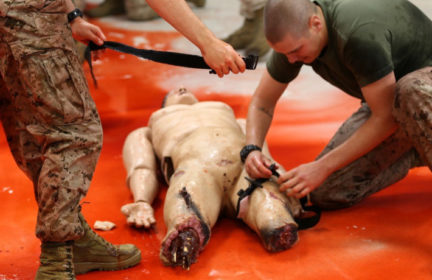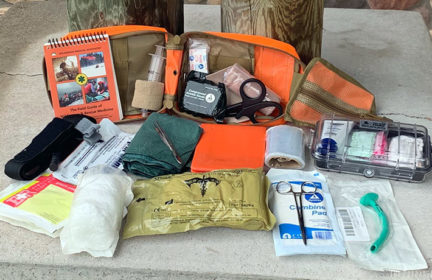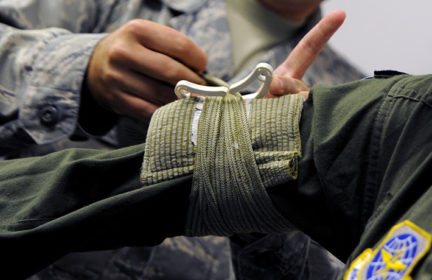About that IFAK tourniquet
Does your kit have one? I’m a bit mystified by the emphasis on this piece of equipment, perhaps because neither firearms nor big hikes are part of my life. My Red Cross and NOLS courses haven’t emphasized a tourniquet — even kind of discouraged it. But the perfectionist in me is conflicted. Why should a suburbanite like me consider investing in a tourniquet?
-
Best Replies
Tom RaderStaff Tom Rader - June 24, 2020
Tourniquets are no longer a “last resort” option and have a number of uses. Their primary purpose is to buy you time until you can control bleeding with well-aimed direct pressure–though in some cases you might be unable to get that in which case the tourniquet stays on. The mindset about tourniquet removal has definitely changed though.
A use case for a tourniquet might be that you put one on as a hasty intervention to stop bleeding until you can get to a safer location. We have also used them during wound cleaning on extremities–it keeps the wound clear of blood and numbs the limb (wound cleaning can be an “uncomfortable” process)–they are used in surgery specifically to keep the surgery site clear of blood.
It is one piece of equipment that can significantly change the outcome of an injury and one that is challenging to improvise correctly. Plenty of science backs up the efficacy of quality commercial tourniquets. Good training helps you know when to apply it.
-
Comments (17)
-
Rich DCContributor - June 23, 2020
No medical background, but I imagine its along the lines of “better to have it and not need it, then need it and not have it” and because limb injuries might become more common in survival scenarios. If you’re copping wood with an axe, miss, and take a big chunk out of your foot/leg – my semi-informed understanding is this might be a valid use for a tourniquet. Even if you end up losing a limb because you wait too long, at least you’re still alive?
If you’re near a hospital/have 911 service, thats probably better. But if you’re chopping wood because the utilities are down and thats how your heating you home, and you can’t call 911, it might be a good use case. This applies to other tools, self defense, or if you suddenly find you *have* to start hiking because you’re fleeing your home and have no choice, and have a bad fall, those are other scenarios.
That said, I don’t have one (yet). When I add an axe/hatchet to my tools though, I’ll probably consider it more seriously.
-
Cheri - June 24, 2020
Thanks. I have to smile at the idea of the axe and tourniquet in the same shopping basket. 😉
-
-
hikermor - June 24, 2020
Speaking from an extensive background in wilderness SAR experience, i would say there is nothing wrong with having a tourniquet (it is yet another dressing), but you are unlikely to need it. We often encountered significant bleeding, all of which were controlled by direct or indirect pressure. Treating or being on scene in more than 400 operations in wildlands, we never applied a tourniquet. Much more likely when chainsaws, industrial machinery, etc. come into play.
We did deal extensively with broken, or possibly broken limbs, and possible spinal and cervical injuries. You are more likely to require a backboard than a tourniquet to properly evacuate a victim…
-
Cheri - June 24, 2020
Thank you for bringing all that experience to this question. Really helpful!
-
-
Tom RaderStaff - June 24, 2020
Tourniquets are no longer a “last resort” option and have a number of uses. Their primary purpose is to buy you time until you can control bleeding with well-aimed direct pressure–though in some cases you might be unable to get that in which case the tourniquet stays on. The mindset about tourniquet removal has definitely changed though.
A use case for a tourniquet might be that you put one on as a hasty intervention to stop bleeding until you can get to a safer location. We have also used them during wound cleaning on extremities–it keeps the wound clear of blood and numbs the limb (wound cleaning can be an “uncomfortable” process)–they are used in surgery specifically to keep the surgery site clear of blood.
It is one piece of equipment that can significantly change the outcome of an injury and one that is challenging to improvise correctly. Plenty of science backs up the efficacy of quality commercial tourniquets. Good training helps you know when to apply it.
-
Watermelon Samurai - June 25, 2020
Cheri,
I completely understand your skepticism, but I’ll echo Tom’s comments above (and add that I am not a medical professional).
Back in the dark ages when I was in Boy Scouts, we had it drilled into our heads that you never, ever applied a tourniquet unless it was an absolute life-or-death situation. So you can imagine my surprise when I was taught how to use a tourniquet at a CPR course I took last year at the local hospital! They encouraged us to use it in cases of severe bleeding on extremities where direct pressure isn’t working (or it is, but you’re running out of hands) and when it’s possible to get the victim to proper care reasonably soon.
I questioned the nurse teaching the class specifically about this “new” philosophy, and she reiterated that a tourniquet is now considered a useful tool that does not cause permanent damage when used properly. (She then told the class of a soldier in Afghanistan who had to wear a tourniquet for 48 hours, but did not suffer any permanent nerve damage.) She worked in the emergency room, and strongly recommended that everyone carry a tourniquet in their car because a car accident could easily be a situation where the tourniquet could be useful.
If you’re interested, the “Stop the Bleed” course (stopthebleed.org) teaches how to use a tourniquet properly.
-WS
-
Cheri - June 26, 2020
Thanks! I’ll check out Stop the Bleed.
-
John AdamaStaff - June 26, 2020
Tom (who is an emergency medicine instructor) and the CEO of Stop The Bleed put together this free lesson: https://theprepared.com/survival-skills/guides/tourniquet/
-
Cheri - June 29, 2020
Great! John, any chance we can get a Like button? Or am I just missing it? 😉
-
-
Scott - June 25, 2020
I have RC first aid, Wilderness FA, CERT and done Stop the Bleed twice. I have a couple of North American Rescue (the gold standard) Cat 5 tourniquet. I keep one in my office drawer trauma FAK for active shooter situations and another in my vehicle’s trauma kit in case I come across a car accident.
Do I think that ‘everyone’ should have one? Not necessarily. But, workplace violence is a thing and I work in a building that could be a target of terrorism or other violence, so I have a trauma related kit on hand.
-
Cheri - June 26, 2020
Makes an awful kind of sense. Thanks.
-
-
Scott P - July 5, 2020
Yes, one is in my kits, including the car kits and my ski patrol bag. The science is very good that it can have significant impact on outcomes. The general guidelines have moved to tourniquet first for massive bleeding, especially in remote/austere environments. The Wilderness Medical Society practice protocols place tourniquet application as a primary intervention. They also recommend providers carry two to facilitate conversion in the field in remote locations.
That said even in urban environments EMS will likely not arrive in time for a massive bleed, and even if they do not controlling it immediately has negative affects on outcomes (tertiary fatality peak in ICU). Please consider taking a Stop the Bleed course which will introduce you to these critical skills.
As Tom mentioned improvised is not a good option, the failure rates are higher, and it takes longer. This is a time critical skill, much like initiating CPR and applying an AED during a cardiac arrest.
-
Cheri - July 6, 2020
Thank you.
-
-
woodswalker - July 8, 2020
I absolutely have one in my kits. Great responses here, nothing I could add.
-
hikermor - July 16, 2020
Everyone is talking about the gadget – thee tourniquet. But even more important is the training, and even better, the experience, of applying one properly and handling all other aspects of the situation.
-
John AdamaStaff - July 18, 2020
Yep, you’re not prepared if you just buy gear and throw it in a bag without knowing how to use it! Here’s a lesson on how to use a tourniquet https://theprepared.com/survival-skills/guides/tourniquet/
-
-
Kris DzrContributor - July 20, 2020
Active shooters, vehicle accidents, factory injuries, an arterial cut in the kitchen…
I keep a couple TQs in the car, and one in each first kit and backpack. I also keep a few as trainers. Anytime you have a severe bleed on a limb, slap a TQ on before/while calling an ambulance. They save lives. The quality models that are proven effective don’t cause damage unless left on too long (Ive been told over an hour and they start to get concerned). If you use one to save a life, fire depts/EMTs have been known to give you a new one. Some manufacturers will as well.
I’ve taken several first aid and stop the bleed courses put on by different groups. Some have given them out for free. Get some, practice with it and carry them with you.
-
- News for the week of 2025-07-07 - 5 days ago
- Fun ways to teach kids outdoor/survival skills - 2 weeks ago
- News for the week of 2025-06-30 - 2 weeks ago
- News for the week of 2025-06-23 - 3 weeks ago
- News for the week of 2025-06-16 - 3 weeks ago
This forum is heavily moderated to keep things valuable to as many people as possible. Full community policies are here. The basics:
- 1. Be nice to each other.
- 2. Stay focused on prepping.
- 3. Avoid politics, religion, and other arguments.
- 4. No unfounded conspiracies, fake news, etc.
- 5. Debate ideas, not people.




